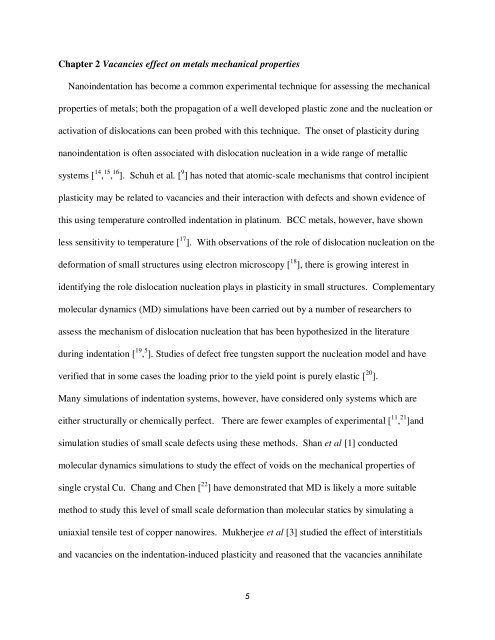DEFECTS IN METALS AND SIMULATION OF MECHANICAL ...
DEFECTS IN METALS AND SIMULATION OF MECHANICAL ...
DEFECTS IN METALS AND SIMULATION OF MECHANICAL ...
Create successful ePaper yourself
Turn your PDF publications into a flip-book with our unique Google optimized e-Paper software.
Chapter 2 Vacancies effect on metals mechanical properties<br />
Nanoindentation has become a common experimental technique for assessing the mechanical<br />
properties of metals; both the propagation of a well developed plastic zone and the nucleation or<br />
activation of dislocations can been probed with this technique. The onset of plasticity during<br />
nanoindentation is often associated with dislocation nucleation in a wide range of metallic<br />
systems [ 14 , 15 , 16 ]. Schuh et al. [ 9 ] has noted that atomic-scale mechanisms that control incipient<br />
plasticity may be related to vacancies and their interaction with defects and shown evidence of<br />
this using temperature controlled indentation in platinum. BCC metals, however, have shown<br />
less sensitivity to temperature [ 17 ]. With observations of the role of dislocation nucleation on the<br />
deformation of small structures using electron microscopy [ 18 ], there is growing interest in<br />
identifying the role dislocation nucleation plays in plasticity in small structures. Complementary<br />
molecular dynamics (MD) simulations have been carried out by a number of researchers to<br />
assess the mechanism of dislocation nucleation that has been hypothesized in the literature<br />
during indentation [ 19 , 5 ]. Studies of defect free tungsten support the nucleation model and have<br />
verified that in some cases the loading prior to the yield point is purely elastic [ 20 ].<br />
Many simulations of indentation systems, however, have considered only systems which are<br />
either structurally or chemically perfect. There are fewer examples of experimental [ 11 , 21 ]and<br />
simulation studies of small scale defects using these methods. Shan et al [1] conducted<br />
molecular dynamics simulations to study the effect of voids on the mechanical properties of<br />
single crystal Cu. Chang and Chen [ 22 ] have demonstrated that MD is likely a more suitable<br />
method to study this level of small scale deformation than molecular statics by simulating a<br />
uniaxial tensile test of copper nanowires. Mukherjee et al [3] studied the effect of interstitials<br />
and vacancies on the indentation-induced plasticity and reasoned that the vacancies annihilate<br />
5

















